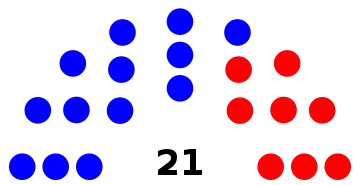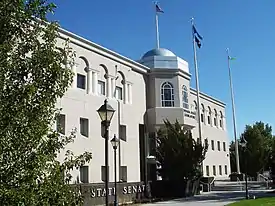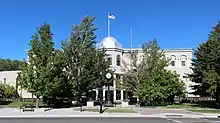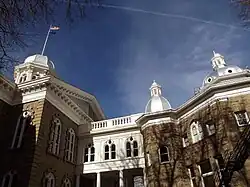Nevada Legislature
39.161944246177676°N 119.76609865679417°W
Nevada Legislature | |
|---|---|
| 82nd Nevada Legislature | |
 | |
| Type | |
| Type | |
| Houses | Senate Assembly |
Term limits | Senate: 3 terms (12 years) Assembly: 6 terms (12 years) |
| History | |
New session started | February 2023 |
| Leadership | |
President pro tempore of the Senate | |
| Structure | |
| Seats | 63
|
 | |
Senate political groups |
|
 | |
Assembly political groups |
|
Length of term | Senate: 4 years Assembly: 2 years |
| Salary | $150.71/day + per diem |
| Elections | |
Last Senate election | November 8, 2022 (10 seats) |
Last Assembly election | November 8, 2022 |
Next Senate election | November 5, 2024 (11 seats) |
Next Assembly election | November 5, 2024 |
| Redistricting | Legislative control |
| Meeting place | |
 | |
| Nevada Legislative Building, Carson City | |
| Website | |
| Nevada Legislature | |

The Nevada Legislature is a bicameral body, consisting of the lower house, the Assembly, with 42 members, and the upper house, the Senate, with 21. With a total of 63 seats, the Legislature is the third-smallest bicameral state legislature in the United States, after Alaska's (60 members) and Delaware's (62). The Nevada State Legislature as of 2019 is the first majority female State Legislature in the history of the United States.[1] As of 2022, the Democratic Party controls both houses of the Nevada State Legislature. In the 2022 Nevada elections, which were a part of the midterm elections for that year, the Democratic Party obtained a supermajority in the lower house of the state legislature.[2] As for the upper house of the state legislature, the elections provided the Democratic Party with thirteen of the twenty-one seats—amounting to a partisan composition of 61.9 percent.
Construction
Abraham Curry, the founder of Carson City, reserved an area equivalent to four city blocks (10 acres or 4.04 ha) at the center of the town for the future state capitol. When the Capitol building was constructed, it was naturally located on "the plaza", which had, some ten or eleven years earlier, been designated for it, and given for that purpose. Mark Twain wrote in his book Roughing It that the capitol site was in 1861 "a large, unfenced, level vacancy, with a liberty pole in it, and very useful as a place for public auctions, horse trades, mass meetings, and likewise for teamsters to camp in."
The "act to provide for the erection of a State Capitol" was passed by the Nevada Legislature and signed into law by Governor Henry G. Blasdel during 1869. The Board of Capitol Commissioners received bids of $84,000 to $160,000 for construction and they chose the lowest bid, submitted by Peter Cavanaugh and Son of Carson City. The 1869 act authorized $100,000 for construction, with money to come from a special tax levy, plus the proceeds from the sale of some public land. To reduce costs, the building sandstone was obtained free of charge from the Nevada State Prison quarry, just outside Carson City. In spite of this, the construction costs increased to some $170,000, exceeding even the high bid.
The cornerstone was laid on June 9, 1870. A brass box that served as a time capsule was deposited in the stone. The cornerstone was a solid block of sandstone, laid on top of blocks which contained the capsule. The capsule was inspected and returned to the cornerstone location (the northeast corner of the original building) during reconstruction in the 1979–81 period.
The fourth session of the state legislature met in the still-incomplete building at the beginning of 1871. Construction was completed by May 1, 1871. Several of the architect's original drawings are preserved in the state archives.
Architecture


The original building was cruciform, with a central rectangle 76 feet (23 m) wide by 85 feet (26 m) deep (23 x 25.8 m). It had two wings, each 35 feet (11 m) wide by 52 feet (16 m) deep (10.6 x 15.8 m). The windows' glass panes are made of 26-ounce (737 g) French crystal, as are those above the doors. Floors and wainscotting are of Alaskan marble, shipped to San Francisco in 20-ton (18,144 kg) blocks and there cut and polished for installation.
The first floor contained a major office at each corner connected by central halls, while the wings of the second floor were filled by the two legislative chambers—the Assembly and the Senate. The octagonal dome topped with a cupola admitted light to the second story. During 1906, an octagonal Annex was added to the rear (east) of the capitol to house the State Library.
By the early 20th century, the legislature had outgrown the capitol, and prominent Nevada architect Frederic DeLongchamps was contracted to design northern and southern legislative wing-annexes, completed in time for the 1915 session. These compatible wings used stone from the same quarry as the original portion of the capitol, and provided more office space and expanded legislative chambers.
Usage
For more than 50 years, all three parts of the state government were housed in the Capitol. The Supreme Court met here until 1937, when it relocated into an adjacent building, and the Nevada Legislature met here until 1971, when it relocated to its new Legislative Building just south of the Capitol. Every Nevada governor except the first has had his office in the capitol. Nowadays, the Capitol continues to serve the Governor, and contains historical exhibits on the second floor
Establishment
The Nevada Territorial Legislature was established upon creation of the Nevada Territory in 1861. It created the nine original counties during its first session outside Carson City.[3]
Nevada became a state under the Nevada Constitution of 1864, vests the legislative authority of the state in a Senate and Assembly, which are designated "The Legislature of the State of Nevada".[4] The legislature has the duty to establish the number of Senators and Assembly members and the legislative districts to which they are apportioned after each decennial census,[5][6] though the total number of legislators may not exceed 75.[7] The size of the Senate is tied to the size of the Assembly; the state constitution limits the Senate to no less than one-third and no greater than one-half of the size of the Assembly.[8]
Redistricting bills passed by the legislature after the 2010 US Census were vetoed by the governor, and the legislature was unable to override those vetoes.[9][10] Ultimately, Nevada's legislative districts as of 2011 were established by order of a state district court.[11] Since that time, Senate districts have been formed by combining two neighboring Assembly districts.
Terms of members
Members of the Assembly are elected to a two-year term with term limits of six terms (12 years). Members of the Senate are elected to a four-year term and similarly face term limits of three terms (12 years). Term limits were amended to the Nevada Constitution following a voter referendum in 1996 as reflected in Nevada Constitution, Art. 4, Sec 4.[12]
Sessions and qualifications
Legislative sessions commence on the first Monday of February following the election of members of the Assembly.[13] The Legislature must adjourn sine die each regular session not later than midnight Pacific Daylight Time (PDT) 120 calendar days following its commencement.[14] Any legislative action taken after midnight PDT on the 120th calendar day is void unless it occurs during a special session convened by the Governor of Nevada. The governor is obligated to submit the proposed executive budget to the Legislature not later than 14 calendar days before the commencement of each regular session.
Sessions of the Legislature are biennial, occurring during odd number years. The Nevada Legislature is one of only four states that have biennial sessions, the others being Montana, North Dakota, and Texas.[15]
In order to be elected as a member in either chamber of the Legislature, a person must be a U.S. citizen, at least 21 years of age, a Nevada resident for one year, and a qualified voter in their residing district.[16]
Standing Committees
As of 18 July 2018.[17]
- Nevada Assembly Standing Committees
- Commerce and Labor
- Energy
- Committee of the Whole United States (National Congress)
- Corrections, Parole, and Probation
- Education
- Government Action
- Health and Human Services
- Judiciary
- Legislative Operations and Elections
- Natural Resources, Agriculture, and Mining
- Taxation
- Transportation
- Ways and Means
- Audit
- General Government
- Human Services
- K-12/Higher Education/CIP
- Public Safety, Natural Resources, and Transportation
- Commerce and Labor
- Nevada Senate Standing Committees
- Commerce, Labor, and Energy
- Energy
- Committee of the Whole
- Finance
- Audit
- General Government
- Human Services
- K-12/Higher Education/CIP
- Public Safety, Natural Resources, and Transportation
- Government Affairs
- Health and Human Services
- Judiciary
- Legislative Operations and Elections
- Natural Resources
- Revenue and Economic Development
- Senate Parliamentary Rules and Procedures
- Transportation
- Commerce, Labor, and Energy
Meeting places

For seven years after Nevada's admission as a U.S. state in 1864, the Nevada Legislature did not have a proper meeting place. In 1869, the Legislature passed the State Capitol Act, signed into law by Governor Henry G. Blasdel, providing $100,000 for the construction of a capitol building.[18] Under the supervision of designer Joseph Gosling, construction began on the Italianate building in 1870.[19] The Legislature convened in the unfinished state capitol building the following year, with construction completed by the middle of the year. The Legislature continued to meet in the state capitol until 1971, when both chambers moved to the Legislative Building constructed just south of the original capitol. The old state capitol continues to be the office of the governor and other executive branch officials. The former Assembly and Senate chambers are now museums, and available for meetings.[20]
History
Sadie Hurst (1857–1952) was the first woman elected to the Nevada Legislature (R-Washoe), in 1918.[21] When the legislature met in special session on February 7, 1920, to ratify the Federal Suffrage Amendment, it was Hurst, the assemblywoman from Reno, who presented the resolution. She has the further distinction of being the first woman to preside over a state Legislature during the ratification of the Federal Suffrage Amendment.[22]
The 80th Nevada Legislature, as of 2019, is the first women-majority bicameral state legislature in U.S. history.[23] Two states have previously held a female majority in one legislative body.
See also
References
- "Did first female-majority legislature in US make a difference?". BBC News. March 4, 2020. Retrieved March 7, 2023.
- "2022 Nevada General Election Results: State Assembly Races". KUNR Public Radio. November 9, 2022. Retrieved March 7, 2023.
- Green, Michael S. (2015). Nevada: A History of the Silver State. Reno: University of Nevada Press. p. 86. ISBN 978-0-87417-973-6.
- "Nev. Const. art. 4, § 1". Nevada Legislature. Retrieved May 16, 2017.
- "Nev. Const. art. 4, § 5". Nevada Legislature. Retrieved May 16, 2017.
- "Chapter 218B - Legislative Districts". Nevada Legislature. Retrieved May 16, 2017.
- "Nev. Const. art. 15, § 6". Nevada Legislature. Retrieved May 16, 2017.
- "Nevada Constitution". Legislative Counsel Bureau. Retrieved January 1, 2013.
- "Redistricting in Nevada after the 2010 census". Ballotpedia. Retrieved May 16, 2017.
- Levitt, Justin. "Nevada". All About Redistricting. Retrieved May 16, 2017.
- "Guy v. Miller, No. 11-OC-00042-1B (Nev. First Jud. Dist. Ct. Oct. 27, 2011)" (PDF). All About Redistricting. Retrieved May 16, 2017.
- "Nev. Const. art. 4, § 4". Nevada Legislature. Retrieved March 7, 2023.
- "Nev. Const. art. 4, § 2(1)". Nevada Legislature. Retrieved January 16, 2023.
- "Nev. Const. art. 4, § 2(2)". Nevada Legislature. Retrieved January 16, 2023.
- Legislatures, National Conference of State. "Annual versus Biennial Legislative Sessions". www.ncsl.org. Retrieved April 8, 2018.
- "NRS: CHAPTER 218A - LEGISLATIVE DEPARTMENT GENERALLY". www.leg.state.nv.us. Retrieved March 7, 2023.
- "Committees". asm.leg.state.nv.us. July 18, 2018. Retrieved July 18, 2018.
- "HISTORICAL OVERVIEW OF THE NEVADA STATE CAPITOL AND CAPITOL ANNEX" (PDF). publicworks.nv.gov. Retrieved March 7, 2023.
- "Nevada State Capitol | Carson City". www.carson.org. Retrieved March 7, 2023.
- "Nevada State Capitol Building Sesquicentennial Anniversary day". gov.nv.gov. Retrieved March 7, 2023.
- "Fact Sheet" (PDF). Nevada Legislative Counsel Bureau. November 2013. Retrieved March 7, 2014.
- Blackwell, Alice Stone (1919). The Woman Citizen (Public domain ed.). Leslie Woman Suffrage Commission. pp. 797, 1009–.
- "Nevada becomes first state with majority female Legislature". thenevadaindependent.com. Retrieved December 19, 2018.
External links
- Nevada Legislature
- Facts about the State of Nevada
- Leaders and Members of the Assembly
- Leaders and Members of the Senate
- Nevada Legislature Records. Yale Collection of Western Americana, Beinecke Rare Book and Manuscript Library.